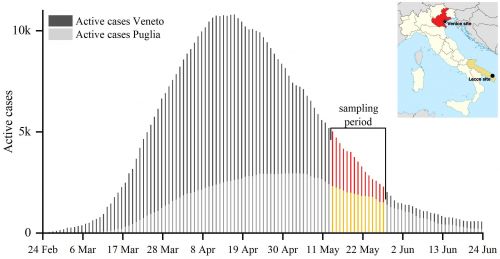
A multidisciplinary study, conducted in May 2020, analyses the atmospheric concentrations of SARS-CoV-2 in Venice and Lecce, highlighting the implications for airborne transmission. The study, published in Environment International, was conducted by Cnr-Isac, Ca' Foscari University of Venice, Cnr-Isp, and Istituto Zooprofilattico Sperimentale della Puglia e della Basilicata.
The rapid spread of SARS-CoV-2, and the generation of outbreaks with different intensity in different regions of the same country, raised important questions regarding the mechanisms of transmission and the role potentially played by airborne transmission. While the transmission of SARS-CoV-2 by contact (direct or indirect via contact surfaces) is widely accepted, airborne transmission is still controversial, especially in outdoors. The multidisciplinary study, conducted by the Institute of Atmospheric and Climate Sciences of the National Research Council (CNR-Isac) of Lecce, the University Ca' Foscari Venezia, the Institute of Polar Sciences of the CNR (CNR-Isp) of Venice, and the Istituto Zooprofilattico Sperimentale della Puglia e della Basilicata (Izspb), allowed to analyse concentrations and size distributions of viral particles in outdoor air collected simultaneously during the pandemic in Veneto and Puglia in May 2020, between the end of the lockdown and the resumption of activities.
The research, started in the framework of the project "AIR-CoV (Evaluation of the concentration and size distribution of SARS-CoV-2 in air in outdoor environments) and published in the scientific journal Environment International, showed a low probability of airbone transmission in residential and urban areas, with the possible exclusion of crowded outdoor sites. "Our study examined two cities with different diffusion of COVID-19: Venice-Mestre and Lecce, located in two parts of the country (northern and southern Italy) characterized by very different rates of spread of COVID-19 in the first phase of the pandemic," explains Daniele Contini, CNR-Isac researcher. During the first phase of the pandemic, the spread of SARS-CoV-2 was exceptionally severe in Veneto region, with a maximum of active cases (i.e. infected individuals) of 10,800 at 16 April 2020 (about 10% of the total Italian cases) out of a population of 4.9 million. Instead, Apulia region reached the maximum of active cases on May 3, 2020 with 2,955 cases (3% of total Italian cases) out of a population of 4.0 million people. At the beginning of the measurement period (May 13, 2020), the Veneto and Puglia regions were affected by 5,020 and 2,322 active cases, respectively.
"The role of airborne transmission depends on several variables such as concentration and size distribution of viral particles in the atmosphere and meteorological conditions. These variables can differ in outdoor and indoor environments," emphasizes Marianna Conte, Cnr-Isac researcher.
The potential existence of SARS-CoV-2 virus in aerosol samples analyzed was determined by collecting atmospheric particulate matter of different sizes from nanoparticles to PM10 and determining the presence of SARS-CoV-2 genetic material (RNA) with advanced laboratory diagnostic techniques. "All samples collected in residential and urban areas in both cities were negative, the concentration of viral particles was very low in PM10 (less than 0.8 copies per m3 of air) and in each size range analyzed (less than 0.4 copies per m3 of air)", Contini continues. "Therefore, the probability of airborne transmission of the contagion outdoors, excluding those very crowded areas, appears very low, almost negligible. In crowded sites, concentrations can increase locally as well as risks due to close contacts, therefore it is absolutely necessary to respect the regulations enforced for avoiding crowds".
"A higher risk could be present in indoor environments of poorly ventilated communities, where the smaller respiratory droplets can remain in suspension for longer periods of time and also settle on surfaces," stresses Andrea Gambaro, professor at Ca' Foscari. "It is therefore desirable to mitigate the risk through the periodic ventilation of environments, the sanitation of hands and surfaces and the use of masks".
"The study and application of sensitive analytical methods with the use of technologically advanced platforms allow, today, to detect the presence of Sars-CoV-2 even at very low concentrations, as it could be in outdoor and indoor environments, making laboratory diagnostics more and more reliable" concludes Giovanna La Salandra, Manager of the Izspb Research and Scientific Development Structure. The concentrations in some indoor community environments will be studied in a second phase of the AIR-CoV project.
D. Chirizzi, M. Conte, M. Feltracco, A. Dinoi, E. Gregoris, E. Barbaro, G. La Bella, G. Ciccarese, G. La Salandra, A. Gambaro, D. Contini, 2020. SARS-CoV-2 concentrations and virus-laden aerosol size distributions in outdoor air in north and south of Italy. Environment International 106255, https://doi.org/10.1016/j.envint.2020.106255
Link open access: https://authors.elsevier.com/sd/article/S0160412020322108
CNR Press release https://www.cnr.it/it/comunicato-stampa/9830
